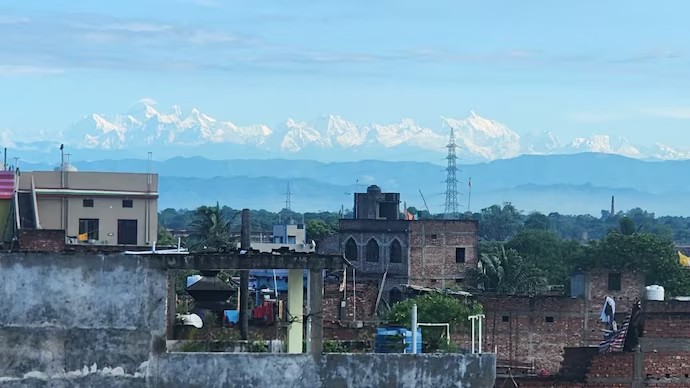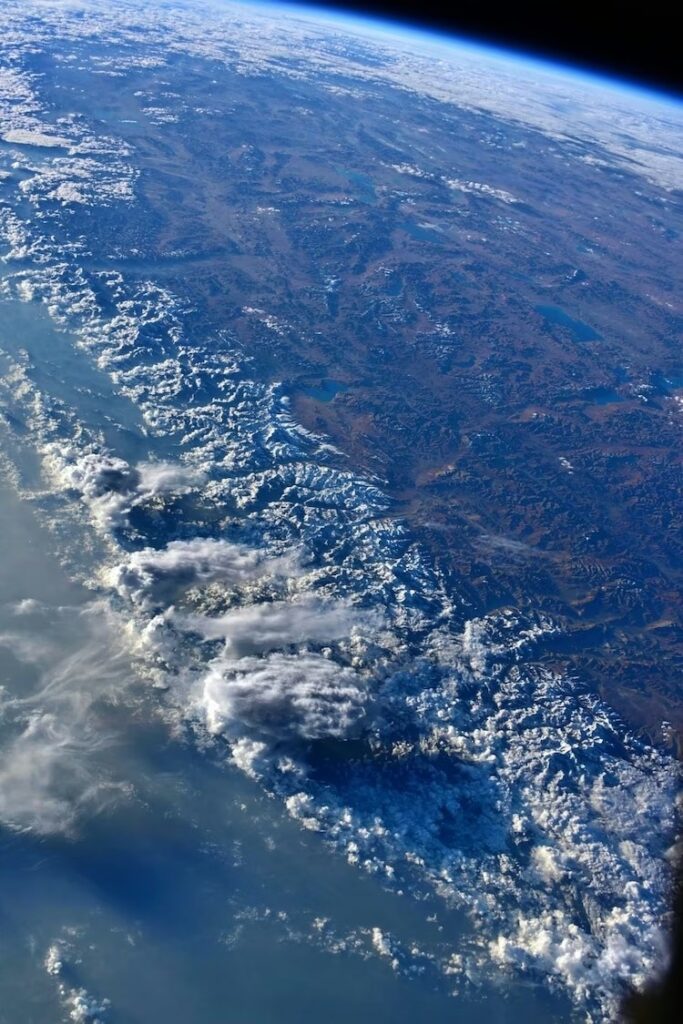Mount Everest visible from Bihar: Astronaut shows how Himalayas look from space
This awe-inspiring perspective comes just as a separate video showing Mount Everest visible from Bihar captured attention across social media, igniting fresh fascination with the world’s tallest peak.

The Himalayas and the Mount Everest as seen from space. (Photo: X/@DonPetit)
A breathtaking image of Mount Everest, as seen from the International Space Station, has gone viral online after Nasa astronaut Don Pettit shared his view of the Himalayan giant and much of Nepal from orbit.
This awe-inspiring perspective comes just as Rare sight: Mount Everest visible from Bihar town thanks to clear skies, clean air
Located on the banks of the Kamla River, which originates from a glacier in Nepal along the India-Nepal border, Jaynagar is a culturally vibrant town where the world’s highest peak appears directly in line on the map.

Although fog, pollution, and clouds may sometimes obscure the view, when the weather is clear, this sight appears throughout the year, sometimes sharp, sometimes faint.
A spell of clear weather and improved air quality has revealed a breathtaking sight from the border town of Jaynagar in Bihar – the snow-clad Himalayan range, with Mount Everest standing tall and visible on the horizon.
Located on the banks of the Kamla River, which originates from a glacier in Nepal along the India-Nepal border, Jaynagar is a culturally vibrant town where the world’s highest peak appears directly in line on the map. When the air is clean and the skies are free from fog, pollution, and clouds, the Himalayan range comes into sharp view, offering a rare spectacle to residents.
The phenomenon, locals say, becomes especially vivid during Chaitra-Baisakh and Ashwin-Kartik, that is, from Vasant Panchami to Holi and Ram Navami, and later from Durga Puja to Kartik Purnima, when the air remains crisp and visibility stretches farther than usual.
From the taller buildings of Jaynagar and from the barrage built across the Kamla River, the Himalayan peaks can be seen changing hues every moment, from copper to gold to silver at sunrise, and again from silver to gold to bronze at sunset, before slowly fading into the evening sky.
The town also serves as the starting station of Nepal’s only railway line, with passengers from Nepal’s Janakpur often travelling to Jaynagar to board the train.
Visible from Bihar captured attention across social media, igniting fresh fascination with the world’s tallest peak.
Don Pettit, a veteran Nasa astronaut, posted the spectacular photograph with the note: “Orbiting the Himalayas mountain range. Mount Everest is in this photo, with much of Nepal visible as well.”

The image was taken during his most recent six-month science mission aboard the Space Station, an assignment that concluded earlier this year after 220 days in orbit.
The photo captures the vast, snow-capped expanse of the Himalayas as viewed from low-Earth orbit.
Everest’s iconic summit stands out dramatically among the ridgeline, while the rest of Nepal’s dramatic topography unspools below. Pettit’s post resonated strongly, with enthusiastic reactions from both the global astronomical community and people of the subcontinent, for whom Everest is both a symbol of natural wonder and national pride.
The Himalayas as seen from space. (Photo: X/@astro_Pettit)
The image was taken during his most recent six-month science mission aboard the Space Station, an assignment that concluded earlier this year after 220 days in orbit.
The photo captures the vast, snow-capped expanse of the Himalayas as viewed from low-Earth orbit.
Everest’s iconic summit stands out dramatically among the ridgeline, while the rest of Nepal’s dramatic topography unspools below. Pettit’s post resonated strongly, with enthusiastic reactions from both the global astronomical community and people of the subcontinent, for whom Everest is both a symbol of natural wonder and national pride.
The astronaut’s spaceborne vantage point coincided with a viral sensation closer to the ground: a video widely shared online showed Mount Everest visible from the Indian state of Bihar. Rare meteorological clarity and minimal air pollution occasionally grant such vivid sightlines, but eyewitness accounts and visual proofs remain rare, and are quickly celebrated when they occur.
Pettit’s post and the viral Bihar video together highlight the enduring fascination with the Himalayas, reminding the world of the region’s natural grandeur.
Such images from space serve not only as feats of science and technology, but as windows into the planet’s beauty, rendering borders invisible and inspiring a sense of global unity as humanity gazes up or, in this case, down from above.
Recently, two different views of Mount Everest captured worldwide attention: a rare video of the peak seen from Bihar, India, and a photograph taken by a NASA astronaut from the International Space Station (ISS).
Mount Everest visible from Bihar: A rare glimpse of the Himalayan giant In an unusual turn, Everest was recently spotted from Jaynagar, Bihar, in northern India. A video shared widely on social media revealed the mountain clearly, a phenomenon that occurs only under exceptional atmospheric clarity and minimal air pollution. Such rare meteorological conditions allow visibility over unprecedented distances, giving residents a once-in-a-lifetime glimpse of the Himalayan giant from the plains.
This extraordinary occurrence underscores how environmental factors like air quality and atmospheric transparency can transform ordinary days into spectacular visual events, reminding us of the interconnectedness between nature and human observation. Both Pettit’s space photograph and the Bihar footage highlight humanity’s enduring fascination with the Himalayas. Whether viewed from orbit or from distant plains, Mount Everest remains a symbol of exploration, resilience, and natural wonder. These viral visuals not only captivate the imagination but also inspire conversations around conservation, environmental awareness, and the beauty of the highest peaks on Earth.
– Environmental factors can enhance visual experiences.
– Highlights interconnectedness between nature and human observation.
– Pettit’s space photograph and Bihar footage showcase fascination with the Himalayas.
– Mount Everest symbolizes exploration, resilience, and natural wonder.
– Viral visuals inspire conversations on conservation and environmental awareness.
– Emphasizes the beauty of the highest peaks on Earth.
Mount Everest spotted from Bihar; astronaut shares stunning view of Himalayas from space: See viral pics A stunning image of Mount Everest from the ISS by NASA astronaut Don Pettit has gone viral, captivating millions. This breathtaking view, alongside a rare video from Bihar showing Everest, highlights humanity’s awe for the Himalayas and the profound impact of these majestic landscapes on our collective imagination. As people share these visuals, discussions about the importance of protecting such natural wonders gain momentum. The merging of technology and nature encourages a deeper understanding of our planet’s fragility. This newfound appreciation can lead to increased advocacy for sustainable practices and conservation efforts. Ultimately, these shared experiences foster a global community united by the appreciation of Earth’s extraordinary beauty. The images serve as a reminder of the intricate relationship between humanity and the environment. They inspire curiosity and a desire to explore the world beyond our immediate surroundings. As more individuals witness these breathtaking views, a sense of responsibility emerges to preserve these landscapes for future generations. Social media plays a crucial role in amplifying this message, connecting like-minded advocates across the globe. Through collective action, we can ensure that the grandeur of our planet endures.
She saw a car-sized object above a Texas farm and found a wayward hunk of NASA equipment 10 Oct 2025, 04:47 AM IST

She saw a car-sized object above a Texas farm and found a wayward hunk of NASA equipment
When Ann Walter looked outside her rural West Texas home, she didn’t know what to make of the bulky object slowly drifting across the sky.
She was even more surprised to see what actually landed in her neighbor’s wheat field: a boxy piece of scientific equipment about the size of a sport-utility vehicle, attached to a massive parachute, adorned with NASA stickers. She called the local sheriff’s office and learned that NASA, indeed, was looking for a piece of equipment that had gone lost.
“It’s crazy, because when you’re standing on the ground and see something in the air, you don’t realize how big it is,” she said. “It was probably a 30-foot parachute. It was huge.”
Walter said she soon got a call from NASA’s

| Columbia Scientific Balloon Facility | |||
 | |||
| SN11 – HiWinds SN12 – Test Flight Fort Sumner Sept-Oct 2025 JPL Remote Salter Test Flight BOOP! HASP Picture-D Elves CDCP Antarctica Dec 2025 – Jan 2026 GAPS PUEO Hical 1 Hand Launch Hical 2 Hand Launch The Columbia Scientific Balloon Facility (CSBF), located in Palestine, Texas, is a NASA facility managed by Peraton. The contract to manage the facility is administered by the Balloon Program Office at Wallops Flight Facility of Goddard Space Flight Center (GSFC).We provide the services of launching large (400 ft. dia), unmanned, high altitude (120,000 ft.), research balloons; tracking, and recovering the scientific experiments suspended beneath them, for NASA centers and Universities from all over the world. The Scientific Ballooning Story Scientific Balloons Video Gallery Palestine Operations Fort Sumner Operations Antarctica Operations Wanaka Operations | |||
Balloon Program Chief: Gabriel Garde CSBF Site Manager: Robert Renko Website Curator: Michelle Johnson Last Updated: October 1, 2025 Privacy Policy AccessibilityView Text Version of this Site  | |||